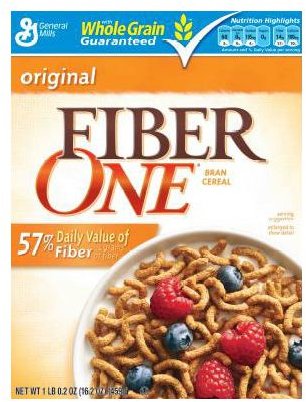Fiber One Cereal Nutrition Information Facts: Details on Calories, Carbs, Fat, Protein, Fiber, Sugars, & Vitamins & Minerals
Even among adult-marketed cereals, Fiber One ranks as one of the most sedate. There’s something about a product label crowing “57% Daily Value of Fiber Per Serving” that gives one pause: do you really want or need that much fiber in one serving? Is there anything else going on with this cereal or is it simply all about the fiber? Well, it is sweetened, and it is fortified with several vitamins and minerals, AND it is made with whole grain wheat, so it’s got those going for it. Here’s the lowdown on Fiber One cereal nutrition information.
Calories
Being denser than many cereals, a serving of Fiber One is only one-half cup, or 30 grams (30g). However, it is only 60 calories per serving, meaning you could afford to splurge and eat more…if your body can handle all the fiber!
Fat
Fiber One cereal has 1g of fat per serving. Half a gram is polyunsaturated fat, while the other half-gram is unaccounted for in the Nutrition Facts. It’s likely, given that the cereal’s ingredients appear to contain only polyunsaturated fats, that the total amount of fat is somewhere between 0.5g and 1g per serving, with 1g being the amount General Mills is legally required to state in the “Total Fat” area and 0.5g the amount required to be stated in the “Polyunsaturated Fat” area.
Either way, Fiber One is a low-fat food.
Carbohydrates
Each serving of Fiber One contains 25g total of carbohydrates, but that’s only part of the story. Fourteen grams of those carbs are dietary fiber, which we’ll go into in the next section.
Sugars are carbs, too, and Fiber One has zero of them. This lack of real sugar contributes to Fiber One’s low-calorie status — it’s sweetened with the artificial sweetener Aspartame, and thus has 0g of sugar. Keep in mind, though, that studies have shown a correlation between use of sugar substitutes and increased appetite, an increase roughly equivalent to when real sugar is used.
Fiber
Fiber, predictably, is where Fiber One’s power lies. This is a cereal designed to make and keep you regular: it contains 14g of dietary fiber per serving, only 1g of which is soluble (digestible) fiber.
While there’s no official recommended daily allowance for fiber, it’s recommend that both women and men get, at minimum, 20–25g of dietary fiber daily. That means Fiber One delivers more than half the daily recommended amount of fiber in one fell swoop. Be careful, though: if you’re not used to so much fiber at breakfast you could be caught unprepared.
Protein
Fiber One isn’t a huge source of protein, providing 2g per serving.
Vitamins
While not quite as fortified with extra vitamins and minerals as some other cereals, Fiber One makes a respectable showing. It has 10% of the RDA for vitamin C, and 25% of the RDA for thiamin, riboflavin, niacin, vitamin B6, folic acid, and vitamin B12.
Minerals
Fiber One adds some minerals to your diet too — 10% of the RDA for calcium, and 25% of the RDA for iron and zinc. Thanks to naturally occurring minerals in the cereal’s whole grain wheat, Fiber One also has 4% RDA for magnesium and 6% of the phosphorus as well.
Conclusion
Like most adult- and health-targeted breakfast cereals, Fiber One cereal nutrition information tells us that it packs a good deal of nutrition in a small package. The use of Aspartame as a sweetener is a boon to diabetics and those who have to count their sugar grams, but is a net negative to everyone else because it has all the effects of real sugar while being an artificial ingredient. This is a shame because otherwise Fiber One is a fantastic way to get high amounts of fiber into one’s diet quickly.
